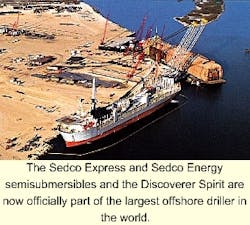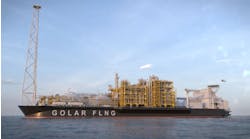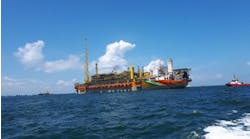Mergers complete, consolidation over
The drilling industry has entered the year 2000 a little bit smaller, but not small enough for some. While consolidation among the drillers remains the battle cry of some of the more recognized figures in the market, it seems that the trend is over - for now.
On December 31, as most of the world was about to welcome in the new year or bunker up and prepare for the paranoid disasters of Y2K, two companies were signing the papers to create the largest offshore drilling company in the world. With the merger of equals complete, Transocean Offshore and Schlumberger's Sedco Forex have combined to form Transocean Sedco Forex a drilling rig contractor with a rig fleet of 75.
However, this was not the only merger of consequence. Nabors and Pool helped reduce the number of competitors with the solidification of their merger. Under the merger, Pool was integrated into Nabors, although Pool will remain a separate entity. The new Nabors companies now have over 500 land rigs, 790 land workover rigs, 45 offshore platforms, 13 jackups, two barge rigs, and 29 marine transportation rigs.
Mergers could be done at a much lower price than during good times, and as a result the process was rampant in most sectors of the industry during 1999. The drillers also seemed to want to combine forces, but had difficulty finding common ground. Unlike other sectors in the industry, the dynamics of merging two drilling companies are different. The common savings with a merger in other sectors can be found in staff and operations, whereas the drillers hold major iron assets that do not offer any savings when combined. As a result, some would rather just buy rigs one by one, rather than purchase an entire fleet.
The Sedco Express and Sedco Energy semisubmersibles and the Discoverer Spirit are now officially part of the largest offshore driller in the world.
But, with commodity prices somewhat steady, day rates improving, and a strong first quarter expected, the merger trend for the drillers may have passed. While very few of the drillers predict a good year (by 1997-1998 standards), it will be better than 1999 and the low price advantage of a weak market has passed on. Therefore, in order to see any additional driller consolidation, it is going to take some major risks from very big figures in the market to pull it off.
Two new semisubmersible heavy-lifts ordered
COSCO Shipping of Rotterdam has signed a contract to build two new state-of-the-art semisubmersible heavy lift vessels with Guangzhou Shipyard in China.
The new vessels will be the only semisubmersible heavy-lift vessels to be equipped with dynamic positioning. The vessels will be class 2 dynamically positioned and feature a new pod azimuth propulsion system along. This will allow the vessels to perform cable laying, pipe laying, and act as a large offshore work vessel.
COSCO's new semisubmersible heavy-lift design. Two vessels are now under construction and will be delivered in October of next year.
The vessels will also be equipped with 44 independent ballast tanks arranged in three levels for safety and versatility and a spud can recess. In addition they will feature a large open deck space of 413 ft by 105 ft and a cargo capacity of 16,000 tons. The cargo deck will be completely open from three sides allowing it to accept loads from a skid-on or roll-on over the side and stern of the vessel. COSCO is considering also adding removable sponsons, which would increase the width of the vessels by another 130 ft.
In addition the vessels will have the unique aspect of having fully removable buoyancy casings, and feature faster ballasting and de-ballasting than other vessels with a total compressor capacity of 8,000 cu meters per hour. This allows for the vessel to complete de-ballast operation in just over two hours.
The vessels will cost about $35 million each and are scheduled for delivery in October of next year.
Global Marine, Harland & Wolff reach agreement
Global Marine and Harland and Wolff (H&W) Shipbuilding have reached an agreement with regard to the delays and cost overruns on the Glomar C.R. Luigs and Glomar Jack Ryan, ultra-deepwater drillships under construction. Global said that due to concern over H&W's financial viability, it has agreed to provide additional funding to the company to ensure completion of the vessels.
According to the agreement, Global has released two cash collateralized letters of credit giving H&W access to $40 million of its own funds. Global also has advanced H&W $93 million above the rigs' $315 million contract price, to be paid in scheduled amounts over the next three months. Global will advance amounts equal to half of subsequent cost overruns until the total advances under the new agreement reach $106 million. In addition, if the maximum advances of $106 million are made, Fred Olsen Energy (the parent company of H&W) has agreed to provide all additional funds necessary to keep the shipyard working long enough to complete the drillships. Fred Olsen also will guarantee up to $4.9 million of H&W's warranty with regard to the drillships.
Global said that if they did fund the maximum $106 million under the agreement and none of the amount was refunded, the total cost of the drillships would be increased by 11%, from $660 million to $730 million, over the original cash outlay projection.
H&W said this liquidity will be sufficient to complete the vessels, which are 90% and 70% complete, and be able to secure further work.
However, Global has strongly refuted H&W's claim for amounts in excess of the contract price, which now total $216 million. Global said it believes all but a small part of the claim to be totally without merit and will resolve the conflict through arbitration. With the new agreement, the drillships will be delivered on the earlier revised time frame of the first quarter for the Glomar C.R. Luigs and as late as the third quarter for the Glomar Jack Ryan.
Samsung's record wins two FPSO contracts
Samsung Heavy Industries, the yard that has received such praise for its timely delivery of the R&B Falcon/Conoco joint venture drillships, is now starting to see the payoff for the on-time work. The company has won two contracts worth a combined $250 million for the construction of two floating production, storage, and offloading vessels. The contracts came from Phillips and Shell and represent $160 million and $90 million, respectively. The vessel for Phillips will be capable of producing and storing 130,000 cu meters of oil and gas condensate, and 95,000 cu meters of liquefied petroleum gas. Shell's vessel will have production capacities of 120,000 bbl of oil and 100 MMcm/d of gas, and storage capacities of 1.47 million bbl of product. Delivery for both vessels is set for early 2002.



